Bulgaria’s overgrown Sunny Beach still has a side of paradise
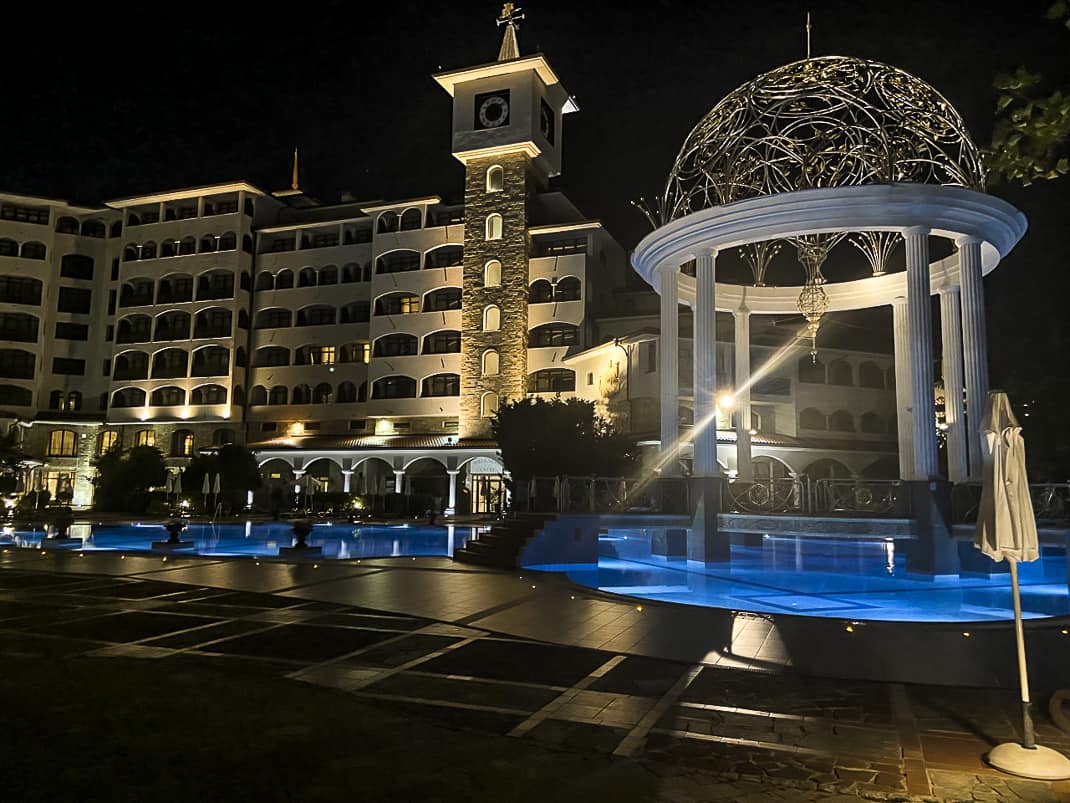
(This is the fifth and final blog on Bulgaria.)
SUNNY BEACH, Bulgaria — I hesitated writing this dateline as, technically, Sunny Beach isn’t a city. It’s classified as a resort. A big resort. A resort that’s five miles long and is made up of more than 600 accommodations. It’s not so much a resort as it is a long string of pleasure palaces interspersed with debauchery at various levels.
Sunny Beach is halfway between Bulgaria’s big Black Sea port cities of Burgas in the south and Varna in the north. I came here near the end of a week-long cross country trip where I plopped myself on the sand for three days after 16 months in Covid isolation in Italy.
I needed pampering. The Royal Palace Helena Sands was the place to do it; June was the time to do it. The world was awakening from its long Covid slumber and the European Union opened its arms to its members. But lingering skepticism, depleted finances and remaining restrictions for many outside Europe kept crowds low. Bulgaria’s most popular destination became the paradise its founding fathers intended.
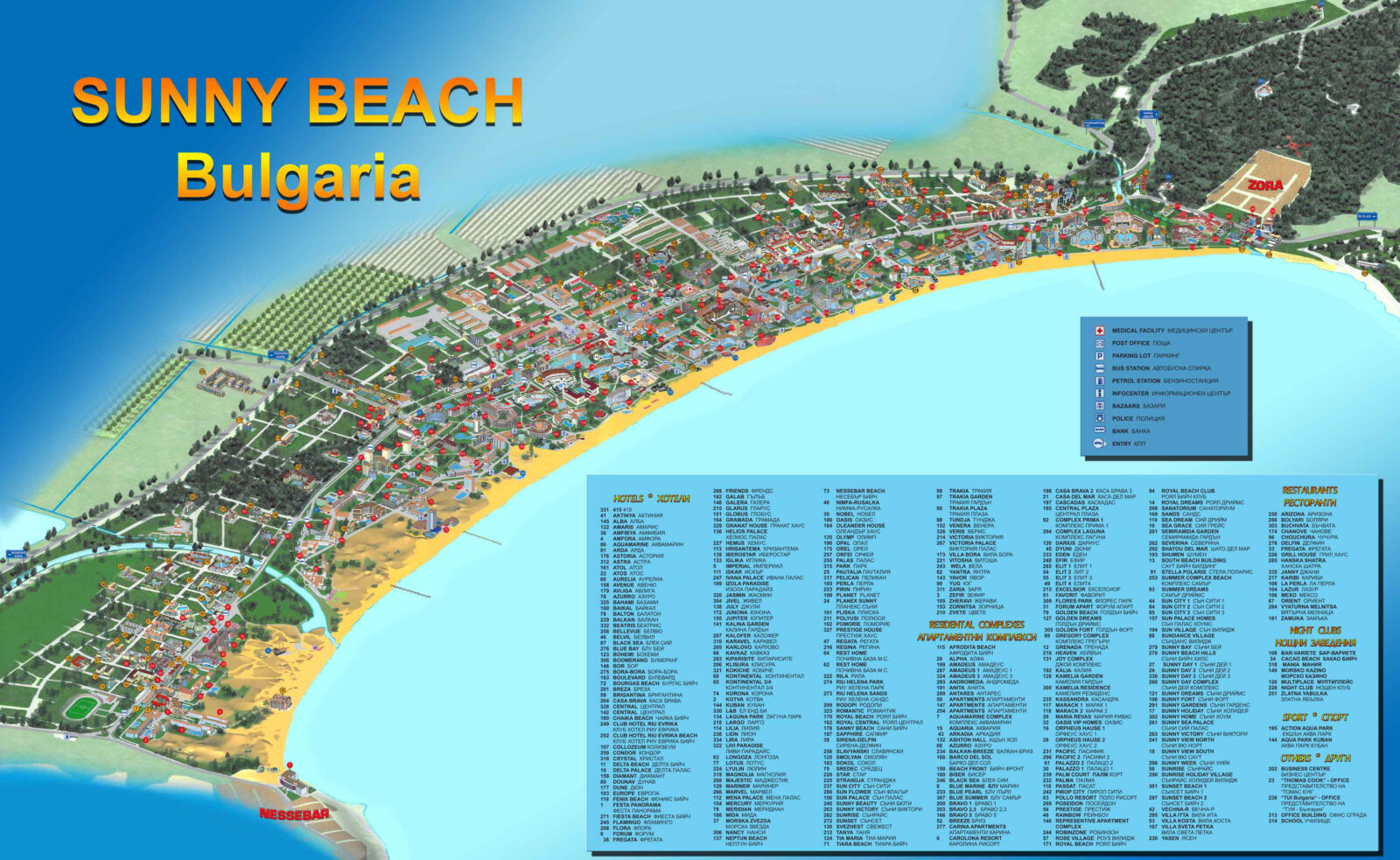
I lived in Las Vegas for 10 years and the Helena Sands gave me flashbacks. It’s a lavish five-star resort with a giant six-column gazebo and dome over a beautiful swimming pool. It’s right on the beach lined with comfy lounge chairs. The resort consists of two huge wings and the lobby is as expansive as the Caesars Palace casino. My huge room had a packed minibar, big bed and big balcony with a view of the sea just over the huge trees between wings. The 200-room hotel was only 20 percent full.
And it was sunny. It was mid-70s and sunny. All week the Internet said it would rain all over Bulgaria. It rained only once, a 15-minute cloudburst in Plovdiv. That’s it. I had heard horror stories about Sunny Beach that rivaled those of Cancun and Ibiza. This would be no horror story. This would be a story added to my long list of European paradises.
The only horror was that I was here alone.
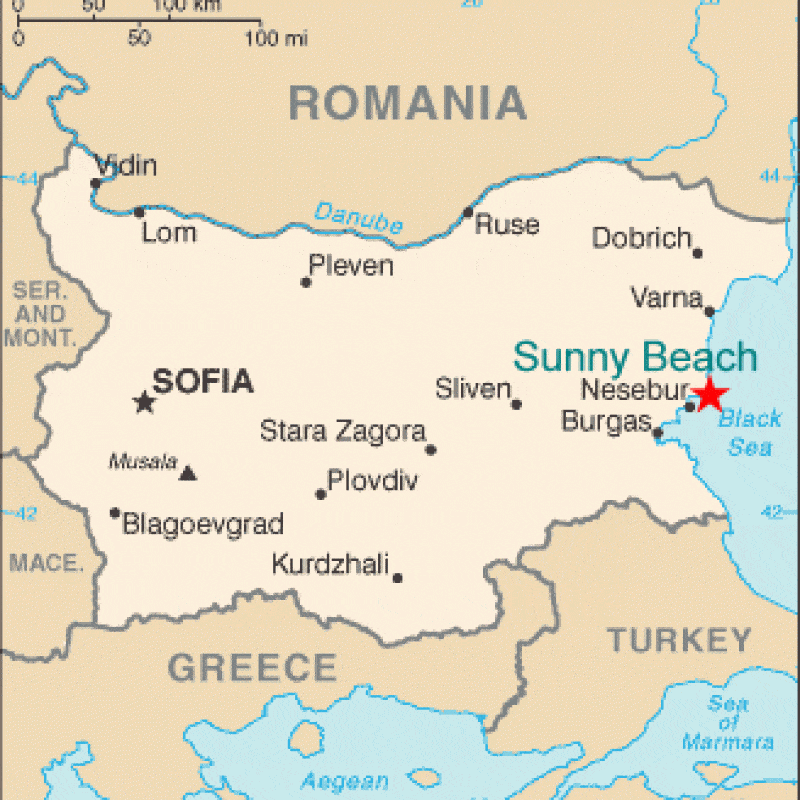
The journey
The bus ride from the ancient city of Plovdiv was wonderful. It started badly.
For the second time on a Bulgarian bus they didn’t even check my ticket. But after I sat down in the big, roomy Greyhound-size bus with air conditioning, a young, mousy, mildly perturbed woman had a ticket for the window seat where a sharply dressed woman sat next to me. It turns out, the woman next to me had the same seat assignment I had. She took my ticket to the bus driver who shrugged. She said, “He said another seat should be available. I’m taking this one. I bought mine a day before you did.”
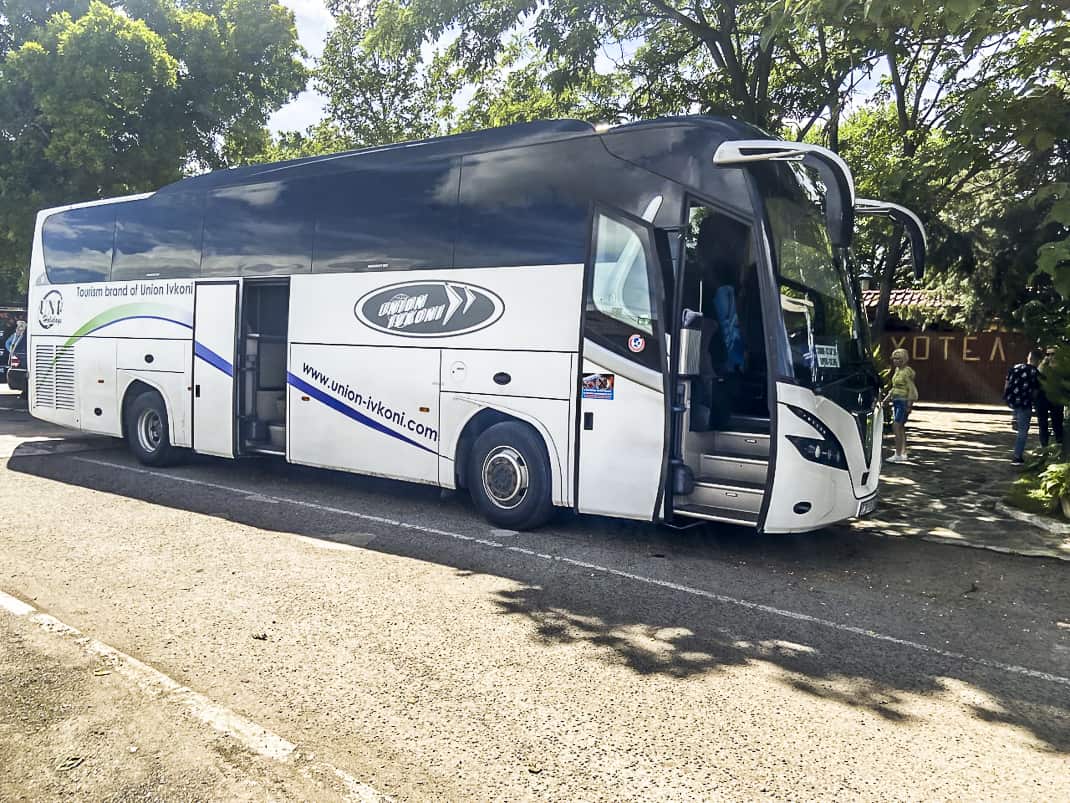
Never argue with logic in a foreign country. I smiled politely and sat three rows back.
The 5 1/2-hour drive to the Sunny Beach bus station (Yes, there is one.) didn’t need an in-bus movie or attractive company. My image of Bulgaria as a stark, barren landscape was shattered with all the agriculture laid out in front of me for many of the 170 miles. I passed many large manicured farms with small, green plants — maybe lettuce or cabbage — with neat irrigation ditches running up the side.
After our second pit stop, we passed fields of lavender and huge farms with little houses, somewhat weather beaten and showing their age. They aren’t the picturesque farmhouses in rural Iowa but not blown-out husks you’d find in Siberia, either. I passed big fields of lush grass and even a field of covered grapevines, a reminder of Bulgaria’s fledgling wine industry. The lone business I saw was a tractor dealership. We also saw a lineup of giant warehouse tankers displaying Bulgarians’ street art chops, such as a beautiful woman’s eye on a purple background and a seagull in full flight.
We went through a little town and saw a small boy holding a fishing pole on a bridge down to a shallow creek. I don’t think he caught anything but the water looked good enough to drink.
In Sliven, a town smack dab in the middle of the country, we saw some drab, concrete apartment buildings but Sliven is a destination, too. It has a huge 500-year-old tree that the Ottomans used to hang Bulgarian dissidents. Today the city preserves it as a nature site, not an historical site.
Bulgaria looks environmentally conscious. It’s not only spotless — locals complain but I saw very little litter and trash cans were everywhere — but they’re environmentalists. I saw one field covered with solar panels with a lone giant windmill slowly turning on a hill.
Two dark-skinned young men in hoodies and sticks led cattle across a field while two children threw a hoop and chased it like frisky puppies. The bright green field dwarfed them. So did the rolling green hills to my right.
Bulgaria is as green as Ireland with better weather.

The hotel
I finally walked into the hotel at 7:30 p.m., just in time for dinner. Breakfast and dinner buffets were included and the dinner didn’t disappoint: Grilled shark, grilled meats, many salads, cheeses, pork in pepper sauce and as much wine as I wanted.
Afterward, I went to the bar where the young, pretty bartender, Kristina, poured me my largest glass of wine since college. It nearly filled an entire red wine glass. I talked to her and her older male counterpart. The man, obviously a communist-era alum, said 40 years ago Sunny Beach had only a handful of hotels. Most of Sunny Beach was built up after communism fell in Bulgaria in 1990.
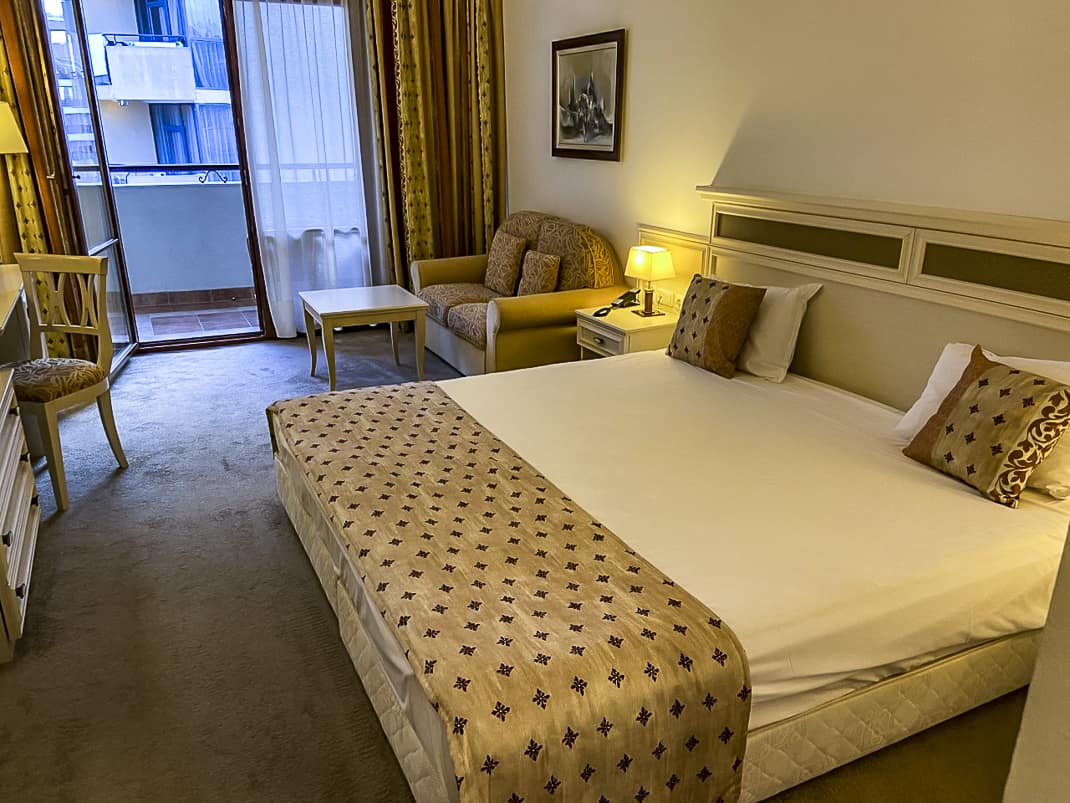

Later, after sitting on a beach and gazing at the calm Black Sea, I went to the poolside bar and met a waiter, Stefan, who was born in 1969. I asked if he misses communism.
“No!” he barked. “After the communists took over, the government made a deal with the Greek government. They took 500 hectares (about 1,235 acres) from my mom. My grandpa was 4 years old and lost land in Greece.”
I said many in Bulgaria say good things about communism.
“For the people, for the masses, this is an illusion,” he said. “Communists make illusions. For example, everybody would enjoy a place to sleep and a place to work. Communism says, ‘Welcome! We will give you work. We give you money.’”
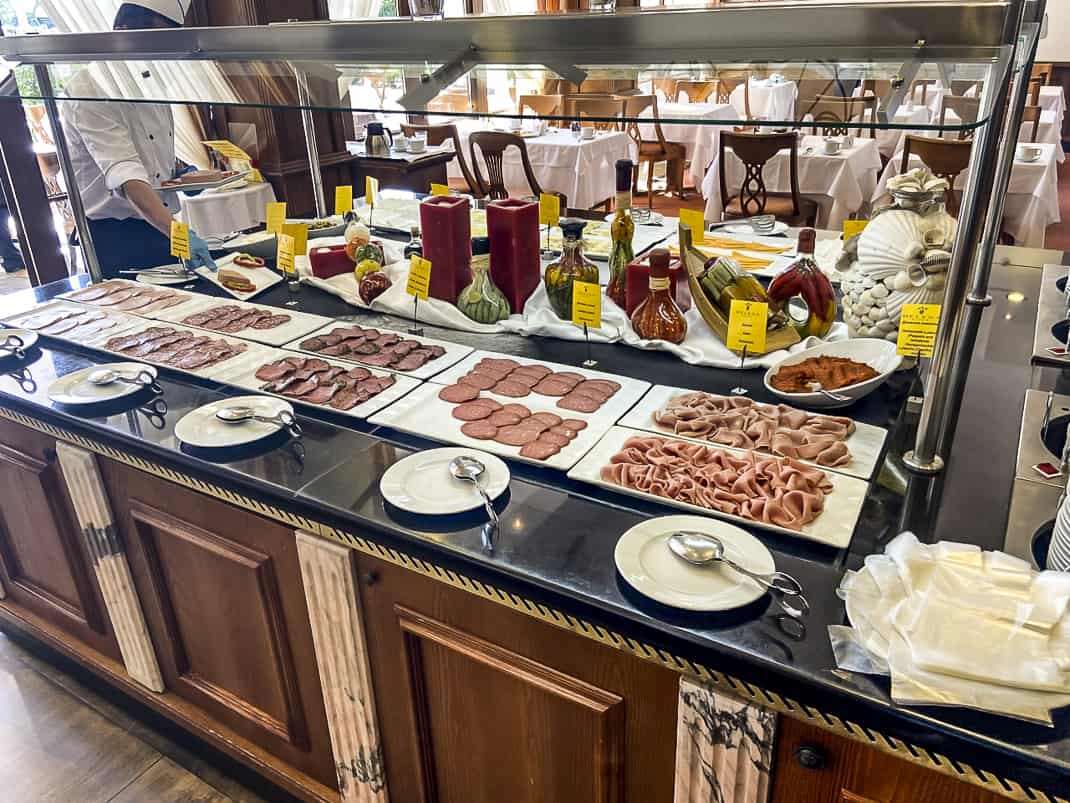
Yes, they had money but they had nothing to buy. They had a job but nothing to work for. Communism is a system that strives for mediocrity and it’s human nature not to be mediocre. The lingering problem hanging over much of Eastern Europe today is people have things to buy but little money to buy them with.
Then again, maybe Sunny Beach had more charm in simpler times. I remember interviewing a tour guide in Cuba in 2013. He asked why I came. I said I wanted to see Cuba as it is, before Fidel Castro dies and it becomes another Miami Beach. He said, “I make $25 a month. I HOPE it becomes another Miami Beach.”
But what has happened to Sunny Beach has proven me right to a degree.
I read a disturbing review of Sunny Beach from Nomadic Matt, a highly respected budget travel blogger who listed it as one of the worst places he’s ever been along with Ko Phi Phi, Thailand. In his blog, NomadicMatt.com, he wrote in 2019 that Sunny Beach has gone from a little village to an overrun tourist trap filled with nightclubs, overpriced drinks and crowds.
“If you’d blindfolded me, drugged me, and woken me up in Sunny Beach,” he wrote, “I could have easily said I was in Kuta Beach, Phuket, Cancun, or any number of cookie-cutter beachy places in the world.”
I wondered what I was missing. After my first full day here, it became the perfect anecdote for emerging from a global pandemic. I spent the morning by the pool with only about five other people, then on the beach with about 10 other people. Global pandemics that kill 4.1 million worldwide sure does wonders for tourist traps.
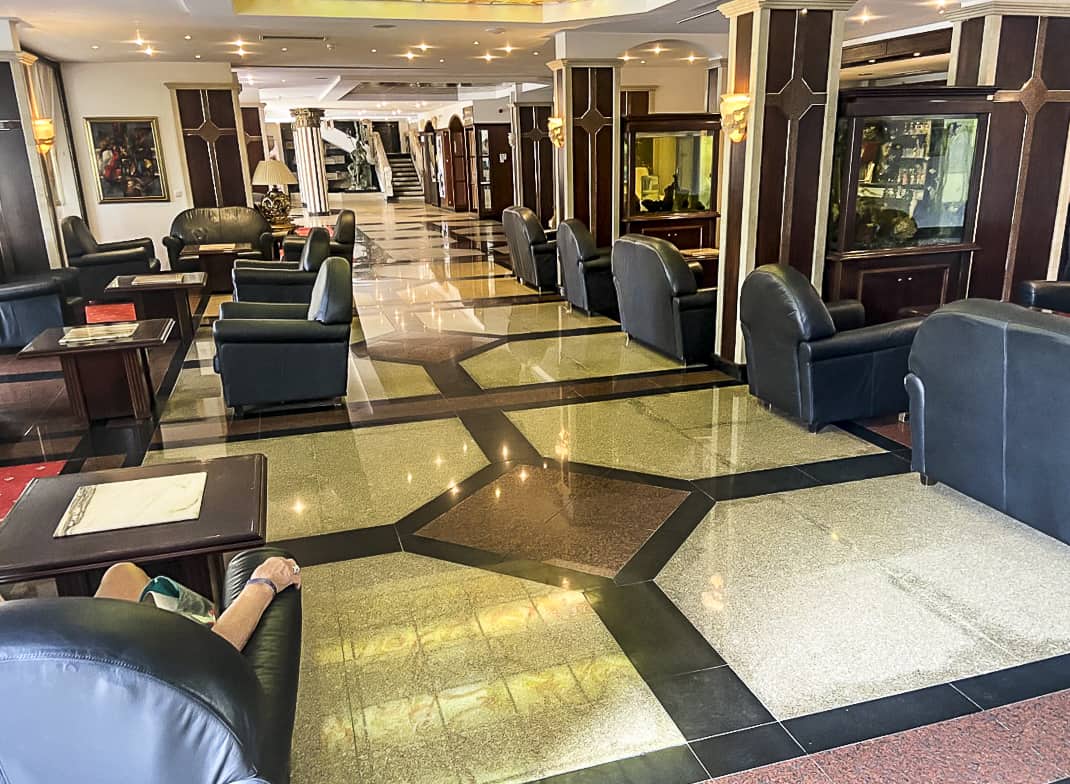
Curious, I went to the front desk and asked. A desk clerk dug out a map of Sunny Beach and the hotels’ place names nearly covered every centimeter of map space. However, at the far northern tip, far from the bus station in the center and the water parks and nightclubs stood Helena Sands. I was way away from the fray. The desk clerk said even in the height of summer the hotel is quiet.
I exhaled. I do NOT like contributing to tourist traps. It’s why I put Cancun atop my list of places I hate.
But Sunny Beach definitely isn’t your father’s Bulgaria. After doing all but nothing for six hours, I ventured up and down the beach for an hour. There is still an interesting mix of East vs. West. Remnants of communist-era marketing are prevalent everywhere. Start with the name. Let’s see. It’s sunny. There’s a beach.
Let’s call it Sunny Beach.
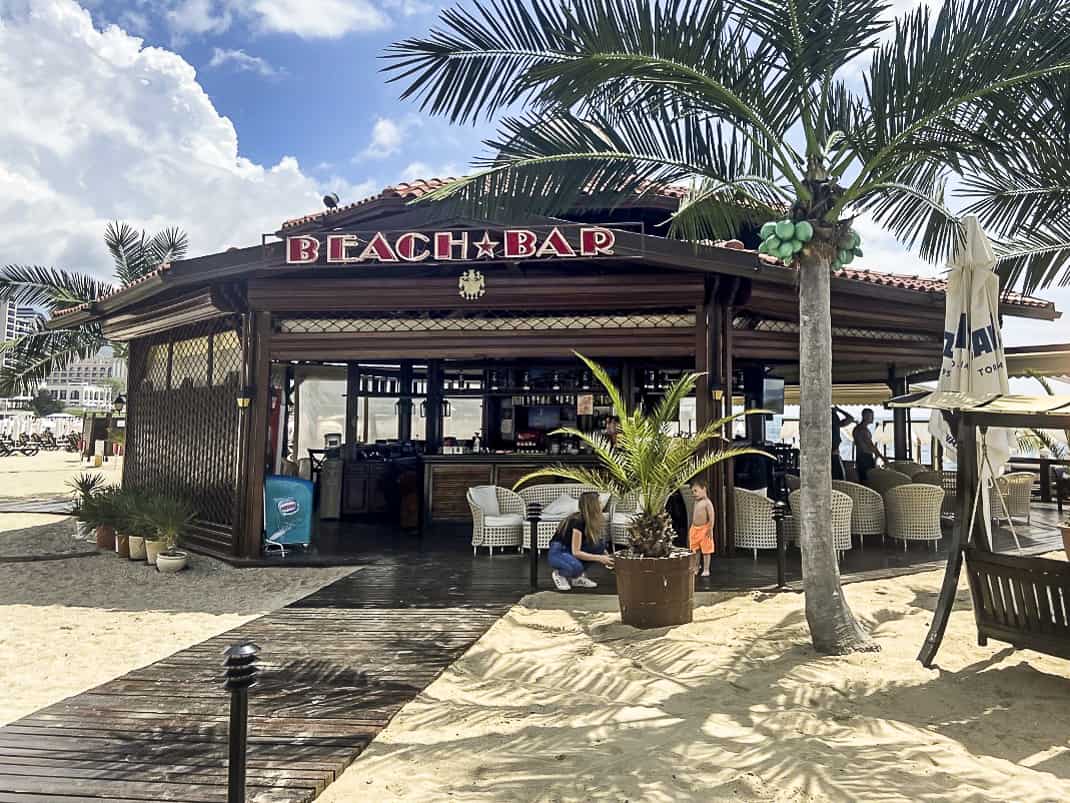
Let’s put a beach bar on the beach and call it, um, Beach Bar. That’s it. Beach Bar. There’s also a souvenir shop that is called Souvenir Shop.
But they do add some nice touches. Red and white flowers bloom from big blue planters shaped like big vases on the stone entrances to the beach. One swath of beach features a string of cabanas complete with curtains for any private beach encounters.
At the farthest point north is a hotel called Sunny Bay with a sign at the entrance reading, “The philosophy of the perfect holiday.” The only sounds I heard were seagulls squawking, a stray baby crying and the rhythmic beat of knock-off pop hits from Beach Bar. Two jet skis raced off in the distance.

A very heavy, well-tanned man lay prone on the beach with a towel over his face and his belly, even laying down, cascading down over his badly sagging Speedos. His arms lay out as if he’d been crucified. Yet he seemed at peace.
But the more south I walked, the more commercial it got. The beach really is lined with lounge chairs. And they all are matching depending on the hotel.
The Majestic hotel has a pink and white motif with a bubbling fountain with water forming little pools in the rocks. Farther down, the Imperial looks airlifted from Las Vegas. A statue of Caesar riding a horse stands in front of a copper-domed gazebo at the pool where two small bridges cross over to the gargantuan hotel. Horn-tooting angels line the columned gate.

The place was packed. Couples. Families. Children. It looked dreadful, like Las Vegas’ Treasure Island Hotel, a kids-friendly hotel that unfortunately lured me in by its discount price.
I button hooked back to my hotel for another Slurpee-sized glass of wine. I tried getting Stefan to go more in depth about his communist philosophy from the night before. He looked sad, shook his head and said, “Unless you lived in it, you wouldn’t understand.”
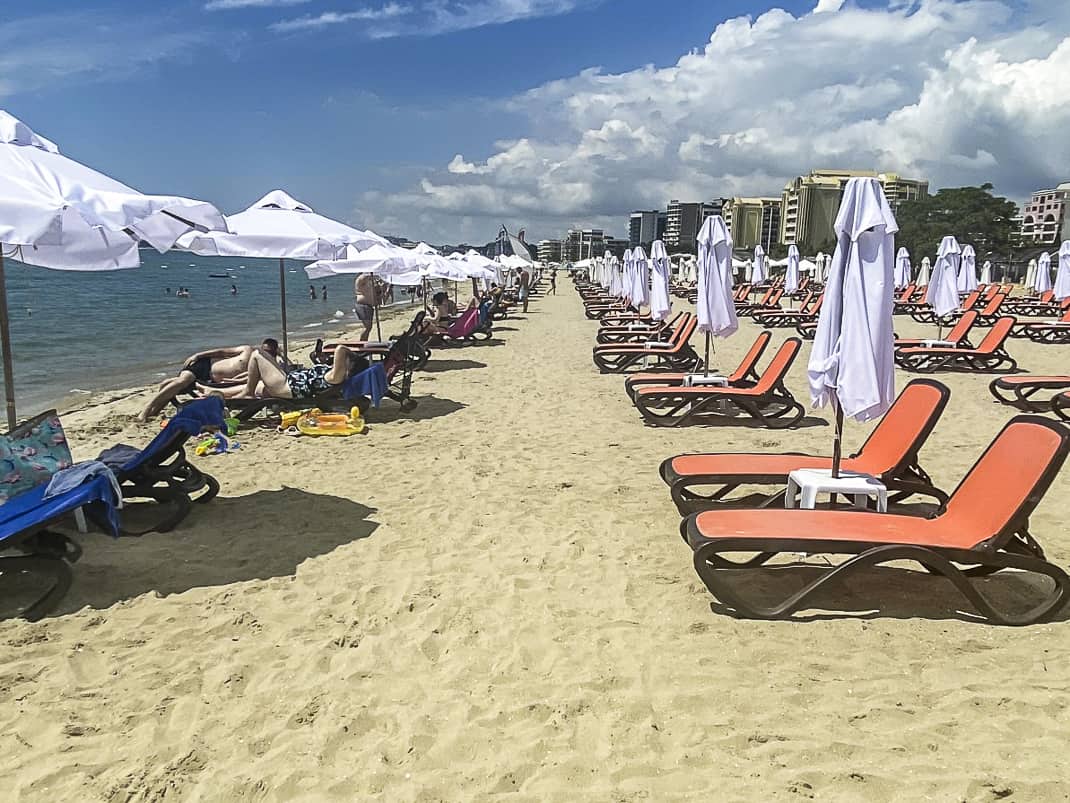
The history
But under the communists, Sunny Beach was born.
The plan started in 1957 when this area was nothing but sand dunes. In 1958, the Bulgarian government chose it as a weekend getaway for Bulgarians. In 1959 the first restaurant opened called the Neptune.
Then Bulgarian construction dug in. They moved 550,000 square meters of soil to the complex, planted 300,000 trees, 770,000 shrubs and 100,000 roses. Stefan the waiter showed me a picture from Lostbulgaria.com and in 1970 there were about five hotels here. Pictured on a simple beach was a pale Bulgarian couple with ugly swimsuits. Even on a beach in 1970 they didn’t smile.
However, the growth continued. Sunny Beach became the first Bulgarian resort to get the Blueflageco award. And the tourists came. The 1 millionth arrived in 1969, the 2 millionth in 1973. By 1988 they had attracted a total of 7.7 million tourists, 5.1 million from outside Bulgaria.
In the mid-2000s it exploded. According to the International Journal of Applied Sciences in Tourism and Events, at the end of the ‘90s buildings in Sunny Beach occupied only 20 percent of the territory. The rest was walkways, parks and green zones.
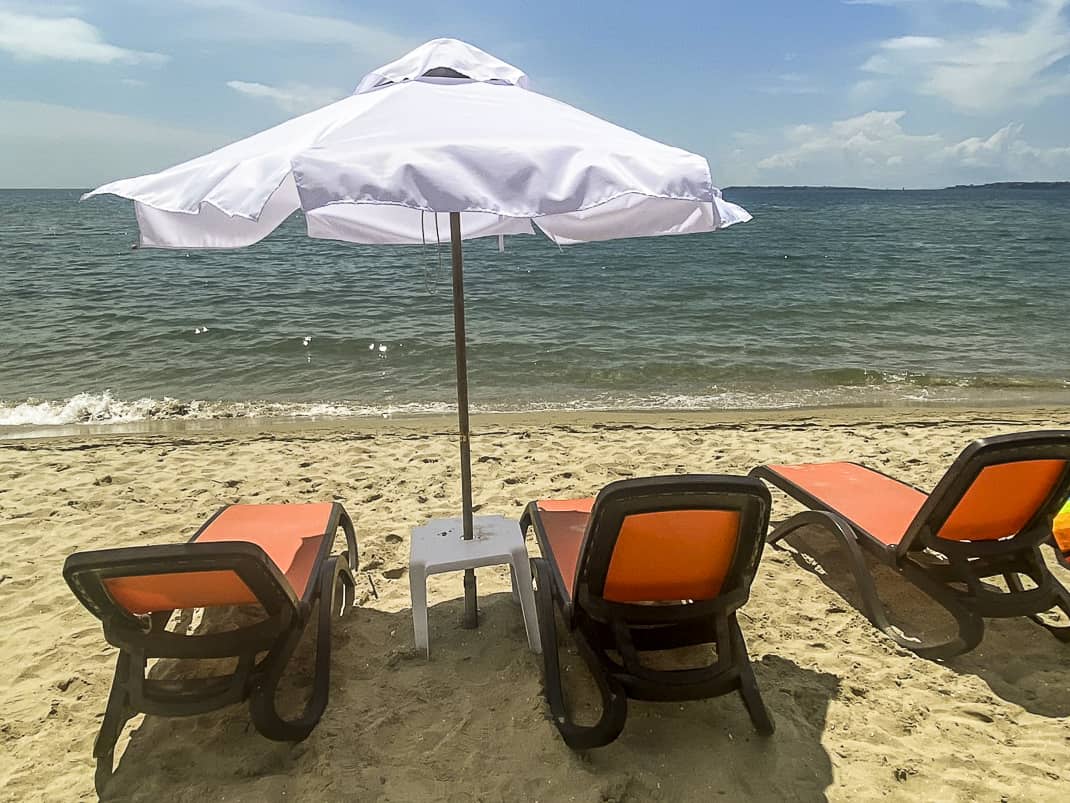
By the end of 2019, building density topped 80 percent.
Specifically targeting young, foreign tourists, Sunny Beach originally planned for 30,000 beds. Today there are more than 160,000, according to the National Statistical Institute of Bulgaria. Some Bulgarian media reports the number is more than 300,000. From 2010-17, accommodations jumped from 322 to 640. Overnight stays hit 5.3 million in 2017, a 67 percent increase in seven years.
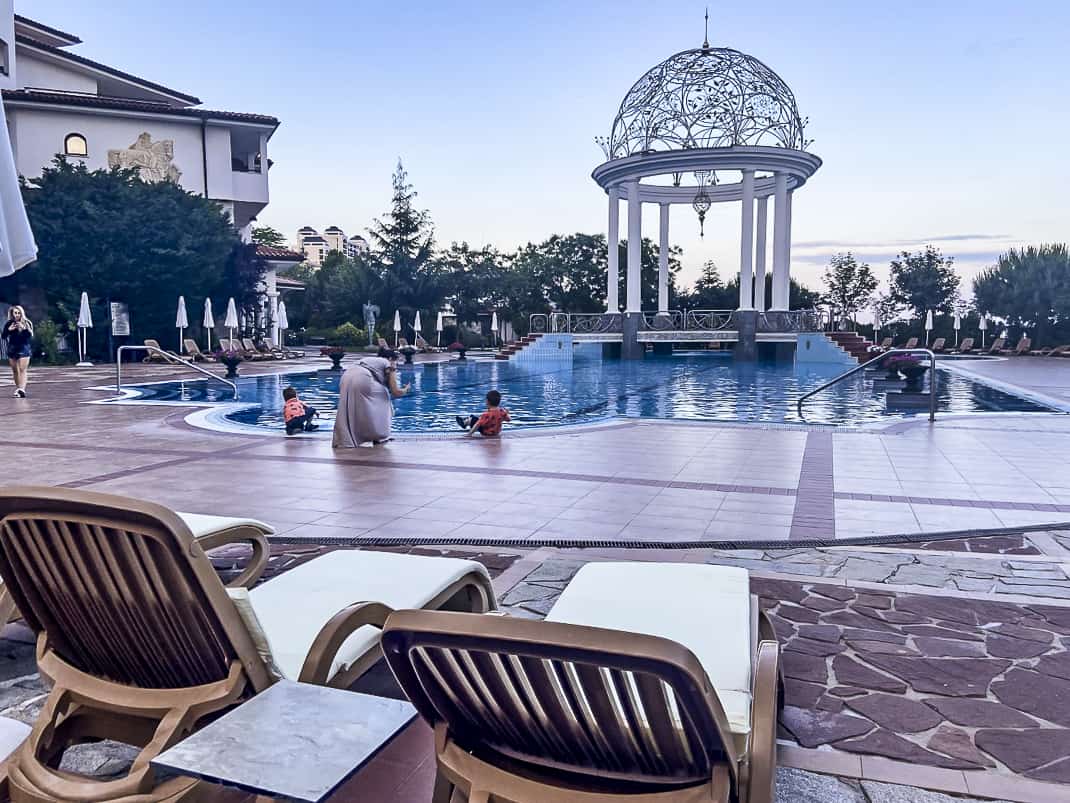
Wrote Mincho Slavov and Rety Palupi in their report in the International Journal, “As a result, Sunny Beach, located in highly ‘instagrammable’ and picturesque spot on Bulgarian Black sea coastline, is attracting predominantly party-loving youngsters, seeking wild parties, inexpensive drugs, drinks, and sex. Bar crawls trips, strip clubs and even drug prices (although drugs possession and consumption are illegal according to the Bulgarian law) are widely and freely discussed on social media and online and used as a promotion tool targeting young (18-30 years).
“It seems that all parties involved in Sunny Beach’s development and marketing – DMOs, tourism business, stakeholders, and policymakers, are not considering the over-tourism as an issue, which hampers the understanding and preventing the over-tourism. Therefore, over-tourism problems are likely to continue to occur within such a mindset, impacting, and leading to future degradation and diminishing the image of Sunny Beach as a quality leisure destination.”
I’m glad I missed the mess. In my little corner of Sunny Beach I didn’t feel as if I could’ve been in Cancun or Ibiza. I felt like I could’ve been in the Bahamas or Greece. Overtourism hadn’t hit that far north and for someone who loathes tourism run amok, Helena Sands became one of my many pleasant surprises in Bulgaria.
Positives and negatives
To close my Bulgaria series, here are the five biggest positives and negatives I found in one of my new favorite countries in Europe:
POSITIVES
- Prices. Bulgaria is cheap. It’s the cheapest country I found in Europe. Delicious meals in colorful restaurants for only 20 euros. Cabs, when I get them, are 2-4 euros. My two-hour bus ride from Sunny Beach to Varna was 6. Big beers are 2. My three-star hotel near the center of Sofia was 32. You get a big bang for your buck in Bulgaria.
- Plovdiv. As a cultural center, this blew away Matera. It’s 2,000 years of history slowly unfolding in the city’s layout. So many pedestrian streets, I barely heard any traffic. Everyone was out. It’s fun, quiet and fascinating.
- Sofia’s beauty. I rank this just out of surprise. Who knew? I always equated Sofia with Bucharest as having too much leftover communist gray. Sofia is not Bucharest. It’s covered with parks, big trees, lots of public squares and beautifully lit monuments. They’re all left over from the communist — and Roman — days but they’re still lovely reminders of the haunting past.
- Food. It challenges Hungary for my most underrated cuisine in Europe. Bulgaria’s variety of big, fresh salads meet the hype. I loved the grilled meats and the meatballs. I live in Italy, the land of appetizers, and Bulgaria’s spreads are terrific. Whoever heard of katuk, goat cheese mixed with sheep’s milk and seasoned with grilled peppers and walnuts? And I could live every day on banitsa, the puffed pastry filled with cheese served everywhere. For you yogurt fans, it was born in Bulgaria.
- The Black Sea. At least during a pandemic, it’s clean. It’s also finally warm enough to swim. Very refreshing and not the swamp that I read about. And my hotel was right out of the Guide for Pampered Travelers.
NEGATIVES
- National bus system. No one could figure out the schedules online. My hotel clerks were baffled. There are so many companies with competing schedules. Buses often fill so I constantly felt a need to reserve a seat. Advice: Go to the bus station and ask. Many clerks speak English.
- Taxis. The drivers know nothing. The Hebros is one of the most famous hotels in Plovdiv. The cabbie asked directions twice. They also won’t take you on short rides. My City Avenue Hotel in Sofia isn’t far from the center but too far to walk. Two or three cabbies refused to take me there.
- Yogurt. Sorry. It’s just my personal taste. They invented it. I still hate it. Plain yogurt really does taste like sour bacteria. Give me the processed fruit flavored yogurt filled with chemicals and preservatives every day.
- Gifts. It’s a pretty weak selection for men. I bought Bulgaria’s famed rose water for women in my life. For men there are religious artifacts and lots of pottery. I only bought myself a postcard. Disclaimer: I didn’t dedicate much time to shopping. I didn’t visit any of Sofia’s public markets.
- (I can’t think of a fifth. Yes, Bulgaria was that positive.)
In case you want to go …
How to get there: Bulgarian Airlines and RyanAir fly from Sofia to Varna and Burgas. The 50-minute round-trip flight to Varna is $70, about $80 to Burgas. Burgas is only 20 miles south of Sunny Beach but has much fewer flights. Varna is 50 miles north of Sunny Beach and my bus was 6 euros. Several buses go direct from Sofia to Sunny Beach. The 6 ½-hour ride starts at 13 euros one way.
Where to stay: Royal Palace Helena Sands, 359-0554-20010, www.helenaresort.com, info@helenaresort.com, double rooms in August start at 170 euros and 107 in September. I paid 150 in June. Five-star resort with lavish swimming pool right on beach with expansive breakfast and dinner buffets included.
When to go: June and September are ideal. Like most of Europe, it gets very crowded in July and August. Temperature when I was there in June hovered in high 70s and low 80s. It reaches mid-80s in July and August.
For more information: Ministry of Tourism: www.tourism.government.bg; National tourism portal: www.bulgariatravel.org; www.gotoburgas.com.

